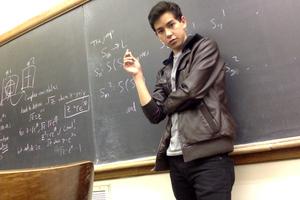Splash Biography
SPENCER ROGERS, Senior in Physics
|
Major: Physics College/Employer: Yale Year of Graduation: 2017 |

|
Brief Biographical Sketch:
In academia, my interests are varied, ranging from physics and mathematics to philosophy and literature. Outside of the classroom, I like to play sports and video games, especially Super Smash Bros Melee, for which I have a formidable Mr. Game & Watch. I am also a proud member of the Sub-2 Half-Mile Club. I hope to become a theoretical physicist and/or philosopher. I am currently doing research in laser theory. Past Classes(Clicking a class title will bring you to the course's section of the corresponding course catalog)M2671: Intro to Isomorphism in Splash Spring 17 (Apr. 08, 2017)
This class is about recognizing when two things are the $$\textit{same}$$, or have the same $$\textit{structure}$$ (most students will have used isomorphisms in their daily lives without necessarily knowing the term). First, we'll play a game, and get a feel for the subject by talking about the game. Then we'll talk about various isomorphisms — these are essentially correspondences that tell us in what way two things are the same. We'll think about how symmetries of a triangle share structural similarities to the different ways we can order three things, how theories about particles moving in space are like theories about qualities of space itself, and more. An especially interesting course for those who like math and philosophy.
S2692: Quantum Mechanics & Philosophy in Splash Spring 17 (Apr. 08, 2017)
First there was a story about a particle. When this particle moves from one place another, it does so in such a way as to minimize a quantity called the $$\textit{action}$$. It seems to, miraculously, $$\textit{know}$$ where it is going to end up, and which path to take there. Fast forward to the 20th century, and a picture as to how this path selection happens emerges. Experiments involving silver atoms and magnets lead us to question the nature of being itself. The physical laws that govern the motion of the particle seem to account for all conceivable paths at once...
C2145: Intro to Quantum Mechanics in Sprout Fall 16 (Oct. 01 - 15, 2016)
We will begin by discussing experiments that led to the development of quantum theory, then move on to working with the theory in its mathematical form using the simple and illuminating case of 2-dimensional vector spaces, which will allow us to understand the Stern-Gerlach experiment in particular. If time permits, we can talk about philosophical issues such as the many interpretations of QM, and sketch out advanced topics like identical particles, entanglement, etc.
E1954: Information and Computation: Physical Foundations in Splash Spring 16 (Apr. 02, 2016)
An introduction to theories of information storage and manipulation in physical systems, followed by a study of silicon logic gates and biological computers. Theoretical concepts draw from statistical thermodynamics and include configuration space, degrees of freedom, microstates and macrostates, and entropy. Course aims include providing a deep understanding of information representation and communication.
H1956: Shadows in Splash Spring 16 (Apr. 02, 2016)
In the Allegory of the Cave, Plato considers prisoners who, from childhood, spend their lives gazing upon mere shadows of the real. He was pointing to a real condition of humanity, and difficulties inherent in the propagation and possession of knowledge. We'll talk first about the allegory, and then move on to discuss a variety of related topics drawn from philosophy, physics, fiction, and everyday experience.
S1771: Theoretical Quantum Mechanics in Splash Fall 15 (Nov. 14, 2015)
Quantum theory, the prevailing physical theory of light and matter, is beautiful. It says essentially that the state of a physical system is given by a vector (something like an arrow, or set of numbers), $$\psi$$, which lives in a mathematical space called Hilbert Space. Things we can observe, like position, momentum, and energy are represented by mathematical operators that act on vectors in the space. By solving so-called "eigenvalue problems" involving these operators, one may begin to see the different values that the observables can take. The aim of this course is to impart some understanding of what this all means, and hopefully spark some interest in some of quantum mechanics' unintuitive implications-- for instance, we will find that we cannot observe a particle to have a definite position and momentum at the same time.
E1772: Semiconductor Devices (i.e. how the heck do computers store 1s and 0s anyway?) in Splash Fall 15 (Nov. 14, 2015)
Maybe you know something about computers. Maybe you know that they store information as 1's and 0's and run various algorithms to compute- changing strings of 1's and 0's into other strings. But do you have any idea how these 1's and 0's are stored physically? If you've ever wondered, here's your quick and dirty fix. We'll focus on the so called p-n junction, and discuss related devices like diodes and transistors as time permits.
M1659: Basic Quantum Mechanics in Splash Summer 15 (Jul. 25 - 26, 2015)
Quantum mechanics is the physics of small things at low energies. In this regime, our intuitive picture of the world breaks down significantly. I will offer explanations as to why this breakdown is no paradox, and describe in detail the postulates of quantum mechanics. We will then examine mathematically a simple two-state system using matrix methods. Finally, I will describe wave mechanics and the uncertainty principle, with a focus on wave-particle duality.
S1514: Matter and Light in Splash Spring 15 (Apr. 04, 2015)
An introduction to atomic theory, mechanics, and optics. The notion of a path integral and its relation to human experience of matter and light. The wave-particle duality of light and matter.
|
|
